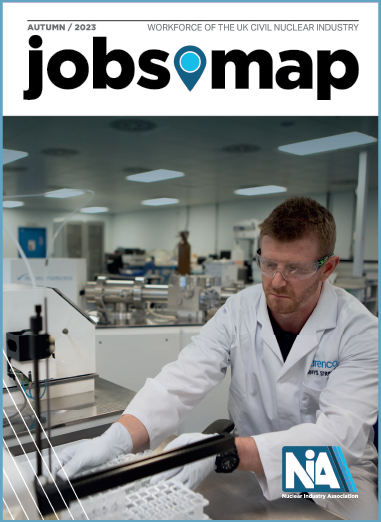Concept art of the Llynfi Energy Project in South Wales. (Source: Last Energy)
American start-up Last Energy has received a letter of interest from the Export-Import Bank of the United States (EXIM), confirming the bank’s willingness to move forward with due diligence for $103.7 million in financing for the company’s project in southern Wales.
President Yuk-Seol Yoon (center) attends a ground-breaking ceremony for Shin-Hanul Units 3 and 4. (Photo: South Korea presidential office)
The U.S. and South Korea have reached a provisional agreement and are working on a memorandum of understanding to advance the countries’ partnership on civil nuclear energy.
Concept art of a Westinghouse AP300 SMR. (Image: Westinghouse)
The United Kingdom’s Department of Energy Security and Net Zero has signed off on Westinghouse’s AP300 small modular reactor earlier this month.
Representatives of Urenco, the United Kingdom, the United States, Germany, the Netherlands, and the IAEA gathered at Urenco’s Capenhurst site. (Photo: Urenco)
Uranium enricher Urenco welcomed representatives from the International Atomic Energy Agency to an August 19 event to mark the creation of an IAEA Centre of Excellence for Safeguards and Non-Proliferation at its Capenhurst, England, site. Representatives of the three nations with ownership stakes in Urenco—the United Kingdom, the Netherlands, and Germany—were joined by representatives from the United States, where Urenco also operates an enrichment plant. Urenco expects the new center to be fully operational in 2025.
Concept art of a Rolls-Royce SMR site. (Image: Rolls-Royce)
Engineering company Rolls-Royce is considering the sale of its small modular reactor subsidiary to inject new funding into the company’s overall business plans, the Sunday Telegraph first reported Aug. 3.
The company is looking to raise hundreds of millions, with a current valuation of £1.6 billion ($2 billion), as it sets its sights on being the first to deploy SMRs in the United Kingdom. Rolls-Royce recently cleared step two of the U.K.’s generic design assessment (GDA)—a competition launched in 2023 to bring SMRs on line in the 2030s.
Rendition of a Rolls-Royce SMR site.(Image: Rolls-Royce)
The small modular reactor design from Rolls-Royce has cleared step two of the United Kingdom’s generic design assessment (GDA) and is moving to the third and final step.
The company announced its progress and lauded “Rolls-Royce SMR’s position ahead of any other SMR in Europe” in a July 30 press release. Rolls-Royce SMR touts its ability to deliver new nuclear power based on proven technology, providing a “factory-built” power station to provide enough energy for a million homes for a 60-year stretch.
The Capenhurst site in Cheshire, England. (Photo: Urenco)
The U.K. government this week announced a $245 million (£196 million) award to help Urenco build Europe’s first advanced reactor fuel manufacturing plant, which will be located in northwest England at the company’s Capenhurst site. Urenco, which is part-owned by the U.K. government, will cofund the project.
A computer-generated rendering of the Sizewell site on the Suffolk coast. Sizewell A and B are to the left and center (respectively) in this image; the section to the right is the Sizewell C area. (Image: EDF Energy)
French nuclear developer Framatome is slated to deliver key equipment for Sizewell C Ltd.’s two large reactors planned for the United Kingdom’s Suffolk coast.
The agreement, reportedly worth multiple billions of euros, was announced this week and will involve Framatome from the design phase until commissioning. The company also agreed to a long-term fuel supply deal. Framatome is 80.5 percent owned by France’s EDF and 19.5 percent owned by Mitsubishi Heavy Industries.
The Hinkley Point C nuclear power plant. (Photo: EDF)
Josh Everett, a diver with UCC UK Ltd., enters bay No. 11 of Sellafield’s Pile Fuel Storage Pond in December 2022, the first time in over 60 years a diver has entered the legacy pond, used to store a variety of spent nuclear fuel types and wastes. During this commissioning nuclear dive, Everett’s underwater tasks included emergency diver extraction trial confirmation, radiation monitoring system verification, and radiation contact meter commissioning. (Photos courtesy of Sellafield Ltd.)
The last time a human entered the Pile Fuel Storage Pond at the Sellafield nuclear site in Cumbria, England, was in 1958, when records show a maintenance operator and health physics monitor carried out a dive into the newly constructed pond to repair a broken winch. At least that was true until December 2022, when Josh Everett, a diver from the U.K. specialist nuclear diving team Underwater Construction Corporation (UCC) UK Ltd., became the first person in more than 60 years to work in one of the most unique workplaces in the world.
















 The present size of the civil nuclear workforce in the United Kingdom is the largest it has been in the past 20 years. So reports the
The present size of the civil nuclear workforce in the United Kingdom is the largest it has been in the past 20 years. So reports the  The Nuclear Decommissioning Authority, the governmental organization responsible for the cleanup and decommissioning of the United Kingdom’s 17 nuclear sites, has released its business plan for the fiscal years running from April 1, 2023, through March 31, 2026. The plan provides a summary of the activities and progress the NDA expects to make at its nuclear sites over the next three years.
The Nuclear Decommissioning Authority, the governmental organization responsible for the cleanup and decommissioning of the United Kingdom’s 17 nuclear sites, has released its business plan for the fiscal years running from April 1, 2023, through March 31, 2026. The plan provides a summary of the activities and progress the NDA expects to make at its nuclear sites over the next three years.